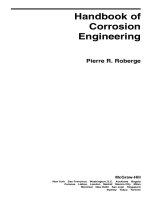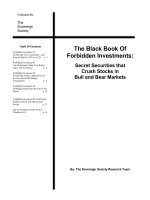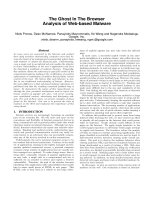The Black Art of Xbox Mods- P1 pptx
Bạn đang xem bản rút gọn của tài liệu. Xem và tải ngay bản đầy đủ của tài liệu tại đây (1.18 MB, 30 trang )
International Standard Book Number: 0-672-32683-3
Library
of
Congress Catalog Card Number: 2004095063
Printed
in
the United States ofAmerica
First Printing: December 2004
The
Black
Art
of
Xbox Mods
Copyright ©
2005
by
Sams Publishing
All
rights reserved. No part
of
this book shall be reproduced, stored in
a retrieval system, or transmitted by any means, electronic, mechani-
cal, photocopying, recording,
or
otherwise, without written permis-
sion from the publisher. No patent liability
is
assumed with respect to
the use
of
the information contained herein. Although every precau-
tion has been taken in the preparation
of
this book, the publisher and
author assume no responsibility for errors
or
omissions.
Nor
is
any
liability assumed for damages resulting from the use
of
the informa-
tion contained herein.
07
06
05 04
4 3 2
Associate
Publisher
Michael
Stephens
Acquisitions
Editor
Neil
Rowe
Development
Editor
Sean Dixon
Managing
Editor
Charlotte Clapp
Project
Editor
Dan Knott
Copy
Editor
Carl Hitchcock
Indexer
Erika Millen
Trademarks
All
terms mentioned in this book that are known
to
be trademarks or
service marks have been appropriately capitalized. Sams Publishing
cannot attest to the accuracy
of
this information.
Use
of
a term in this
book should not be regarded
as
affecting the validity of any trade-
mark or service mark.
Warning and
Disclaimer
Every effort has been made to make this book
as
complete and
as
accurate
as
possible, but
no
warranty
of
fitness
is
implied. The infor-
mation provided
is
on an "as is" basis. The author and the publisher
shall have neither liability nor responsibility to any person
or
entity
with respect to any loss
or
damages arising from the information con-
tained in this book.
Bulk Sales
Sams Publishing offers excellent discounts on this book when ordered
in quantity for bulk purchases or special sales. For more information,
please contact
u.s.
Corporate and GovernmentSales
1-800-382-3419
For sales outside
of
the U.S., please contact
International Sales
Proofreader
Wendy Ott
Technical
Editor
Nathan Cain
Publishing
Coordinator
Cindy Teeters
Interior
Designer
Gary Adair
Cover
Designer
Sandra Schroeder
Page Layout
Susan Geiselman
Contents
at
a Glance
Introduction
Part I:
The
Xbox
Demystified
1 Welcome to the Xbox Scene
2 Disassembling
Your
Xbox
3 Identifying Your Xbox Revision
Part II: Mod
Chips
4 Introduction to Xbox Modding
5 Installing a Solderless Mod Chip
6 Installing a Soldered Mod Chip
Part III:
Software
Mods
7 The Xenium Operating System
8 EvolutionX Dashboard
9 Avalaunch Dashboard
10 Xbox Media Center
Part IV:
Major
Hardware
Mods
1 1 Replacing the Xbox Case
12 Upgrading the Xbox Hard Drive
1 3 Lighting
Up
the Case
14 Cooling Down
Your
Xbox
Appendix
A Xbox Resources
Index
7
19
57
69
83
99
129
157
179
207
233
259
275
289
297
301
Table
of
Contents
What
You
Will Learn
Conventions Used in This Book
Part I:
The
Xbox
Demystified
Chapter
1:
Welcome
to
the
Xbox Scene
"Getting" the Xbox .
Breaking into
an
Industry
Video Game Competition: The
Other
Side
of
the Coin
Learning Some
Hard
Lessons
Xbox Rumors Realized .
Xbox Roots
Timing
Is
Everything
The Game Developer's Dream Machine
Bridging the PC/Console Gap
Promises, Promises
Did
Xbox Work Too
Well?
What
Can
You
Do with Your Xbox?
So What's the Spiel?
Summary
Chapter
2:
Disassembling
Your Xbox
Getting to Know
the
Xbox Hardware
The Case
The
Motherboard
The Power Supply
The
DVD-ROM
Drive
The
Hard
Drive.
The
Central Processing
Unit
(CPU)
The
Graphics Processing Unit (GPU)
Front-Side Bus (FSB)
Media
Control
Processor (MCPX)
Removing the Cover
Removing
the
Rubber Feet
Removing the Six Case Screws
4
4
7
7
8
.9
10
11
11
12
12
13
14
14
15
16
18
19
19
21
22
22
22
24
24
25
.
25
25
26
26
26
Lifting
the
Case
Examining
the
Main
Deck
Removing
the
Hard
Drive
Removing
the
Hard
Drive Tray Screw
Removing
the
Cables
Lifting the
Hard
Drive Tray
Removing the
DVD-ROM
Drive
The
DVD-ROM
Screws
Removing
the
IDE
and
Power Cables
Pulling
the
DVD-ROM
Drive
Removing
the
Motherboard
Removing
the
IDE
Cable
and
DVD-ROM
Power
Connectors
Removing
the
Motherboard
Power Supply
Connector
Removing
the
Motherboard
Screws
Unplugging
the
Controller
Port
Cables
Removing
the
Case
Fan
Removing
the
Motherboard
Summary
Chapter
3:
Identifying
Your Xbox
Revision
Revision Notes
1.0
1.1
1.2
1.3
1.4
1.5
1.6
Methods
of
Identification
Manufacturing
Date
Hardware
Serial
Number
Video
Chip
Verification
Xbox
BIOS Version
Number
Special/Limited
Edition
Exceptions
Halo Special
Edition
Limited
Edition Crystal Pack
Additional
Exceptions
Summary
29
30
32
33
33
35
38
38
38
39
43
44
46
48
48
52
52
56
57
57
57
57
58
58
58
59
59
60
60
61
62
63
64
64
64
65
66
vi
The
Black
Art
of
XBox
Mods
Part
II:
Mod
Chips
Chapter
4:
Introduction
to
Xbox
Modding
What
Is a
Mod
Chip?
How
Does a
Mod
Chip
Work?
Are
Mod
Chips Legal? .
The
Modded
Xbox
Why
the
DMCA
Does
More
Harm
Than
Good
What
Can
You
Do
with
a
Mod
Chip?
Xbox Media
Center
(XBMC)
Homebrew
Games
Overview
of
Available
Mod
Chips
Xenium.
Xecuter .
SmartXX
XBIT
Aladdin
X-Chip
Before
You
Install a
Mod
Chip
Summary
Chapter
5:
Installing
a
Solderless
Mod
Chip
Solderless Xenium Installation
Locating the LPC
Fixing a Pre-Soldered LPC
Locating the
DO
Installing the Solderless Adapter
Installing the
Mod
Chip
Booting Up the
Mod
Chip
Summary
Chapter
6:
Installing
a Soldered Mod
Chip
Removing
the
Motherboard
Installing a
Pin
Header
(All Revisions)
Preparing to Solder .
Locating the
LPe
Removing Pin 4
69
69
70
70
73
74
75
75
76
77
78
78
79
79
.80
80
80
82
83
83
85
.87
88
89
94
.96
97
99
99
103
.104
105
107
Inserting the Pin Header
Soldering the
Pins.
Installing the
DO
Wire
Xbox Revision
1.6
Mod
Chip Installation
Double-Checking the Revision
Installing the Pin Header
Rebuilding the LPC
Installing the LFRAME Wire
Troubleshooting
Problem with the
DO/LFRAME
Problem with the LPC
Other
Problems
Summary
Part
III:
Software
Mods
Chapter
7:
The
Xenium
Operating
System
Overview
of
the Xenium OIS
The Xenium OIS Main Menu
Launch
Disk Tools
EEprom Tools
Settings
Reboot
Recovery
Power Off
Summary
Chapter
8:
EvolutionX
Dashboard
What
Is
EvolutionX?
Installing the EvoX BIOS and Dash
Acquiring EvoX
Installing the EvoX Dashboard
Installing the EvoX BIOS
Creating a Custom BIOS
Using the EvoX Dash
Tweaking EvoX Dash
The EvoX Dash Interface
Creating Your Own EvoX Skins
Summary
Contents
vii
107
110
113
115
115
.116
116
123
125
125
125
125
126
129
129
130
131
134
140
144
155
155
155
156
157
157
158
159
159
160
165
167
167
168
173
177
viii
The
Black
Art
of
XBox
Mods
Chapter
9: Avalaunch
Dashboard
Installing Avalaunch
Customizing a BIOS for Avalaunch
Copying the Avalaunch Files to Your Xbox .
Adding Avalaunch to the Xenium O/S Launch Menu .
Running Avalaunch
Avalaunch Features
The Main Menu
XBox Media Player
Games
Applications
Emulators
File Manager
IRC Client
Telnet Client
Settings
Reboot
Shutdown
Summary
Chapter
10: Xbox
Media
Center
Overview
of
Xbox Media Center
Installing Xbox Media Center
Installing the XBMC Files
Installing a Hacked BIOS
Running Xbox Media Center
The Main
Menu
My Programs
My Files
My Pictures
My Music
My Videos
Weather
Settings
Summary
179
179
180
181
.181
186
.186
186
187
187
191
.191
191
194
194
195
204
205
.205
207
207
208
209
209
211
212
212
215
217
221
224
226
229
230
Part
IV:
Major
Hardware
Mods
Chapter
11: Replacing
the
Xbox Case
Stock Cases
Tearing Down the Old Case
Replacing the DVD-ROM Tray Panel
Assembling the New Case
Aftermarket Cases
Assembling the Aftermarket Case
The System Jewel
Summary
Chapter
12:
Upgrading
the
Xbox
Hard
Drive
Overview
of
the Swap .
The Stock Xbox Hard Drive
The Replacement Hard Drive
Connecting Both Hard Drives
Master/Slave Settings.
Connecting the IDE Cable
Connecting the Power Cables
The Hard Drive Upgrade Wizard
Running the Drive Upgrade Wizard
Formatting the New Drive
and
Transferring Data
Verifying the Upgrade Process
Summary
Chapter
13:
lighting
Up
the
Case
Cosmetic Xbox Modifications
Cold Cathode Lighting
How About a Glowing
Jewel?
Removing the Cold Cathode Bulb
Gluing the Light to the Case Cover
Custom Lighting with LEDs
Creating
Your
Own
LED
Light Show
Building the Main
LED
Wire Loom
Putting
It
All Together
Examining the Cold Cathode Light
The Custom LEDs
Summary.
Contents
ix
233
233
234
·
245
246
.252
·
252
258
258
259
·
259
260
261
·
262
262
264
264
267
267
271
273
274
275
275
277
279
279
281
281
281
283
285
286
286
287
Chapter
14:
Cooling
Down
Your Xbox
Software Cooling Solutions
Setting Fan Speed in BIOS
Setting Fan Speed in XBMC
Active Cooling for Your Xbox
Hard
Drive Cooling
Finding
Room
in the Case
Installing a
Hard
Drive Cooling Fan
Summary
Appendix
A: Xbox Resources
Xbox Information Sites
Mod
Chip Manufacturers
Xbox Hardware Sites
Xbox Software Sites
Index
289
289
290
291
292
294
294
295
296
297
297
298
298
299
301
About
the
Author
Jonathan
S.
Harbou
r has been an avid gamer and programmer for
17
years, having started
with early systems such
as
the Commodore
PET,
Apple II, and Tandy 1000. The first console he
disassembled and tried to hack
was
the Atari 2600. He holds a degree
in
computer information
systems and enjoys writing code in several languages. Jonathan has experience with several plat-
forms, including Windows,
LimlX,
Pocket PC, and Game Boy Advance. Jonathan has written nine
books on the subjects
of
game programming, application development, console programming,
cross-platform programming, and now console modding. He maintains a website dedicated to
these subjects at .
Dedication
For
My
Father,
Martin Scott Harbour
Acknowledgments
This book would
not
exist without all the incredible
amount
of
diligence by individuals who
freely
gave
their hard-earned knowledge to others. This
book
is
not
a unique work by any means,
and although everything described herein was performed by me, I do not take credit for figuring
out anything on my own. I am just a writer!
Yes,
I am a hard-core gamer and programmer,
but
I
am by no means a hardware hacker. What I have done here
is
simply study, build, and explain
how it was done.
To
all
of
you
out
there who tinkered, experimented, and figured it all out, then
shared your knowledge with the world, this book
is
dedicated to you.
This project was a labor
of
love, and I hope it shows in my writing style. I appreciate this oppor-
tunity,
as
my forte
is
software development by
day,
game programming by night. I would like to
thank Sams Publishing for releasing this book. I appreciate the daily encouragement and support
of
Neil
Rowe
and thank Sean Dixon for his hard work. I appreciate the hard-working editors,
artists, and layout specialists at Sams for doing such a fine job. Thanks
go
to Team Xodus for pro-
viding me with several
mod
chips for the development
of
this book. Also, a special thanks to
Artifex and Stealth for the Xenium
as.
lowe
a big thanks to the folks at www.customps2.com for
several clear cases that are featured in this book.
I thank my wife, Jennifer, for putting up with the insane deadlines I faced with this project that
soaked up
all
of
my
free
time for several months. Thank you for being so supportive! I am also
blessed to have two wonderful kids, Jeremiah and Kayleigh, who force me to take a break now
and
then. I thank God for my family.
To
my readers, thank you for buying this book. I am certain that you will enjoy
it!
Finally, to the
open source
community-lighten
up a little!
You
are winning, after all.
We
Want
to
Hear
from
You!
As
the reader
of
this book, you are our most important critic and commentator.
We
value your
opinion and want to know what we're doing right, what
we
could do better, what areas you'd like
to
see
us
publish in, and any other words
of
wisdom you're willing to pass
our
way.
As
an associate publisher for Sams Publishing, I welcome your comments.
You
can email
or
write
me directly to let me know what you did
or
didn't like about this
book-as
well
as
what
we
can
do to make our books better.
Please
note thatI cannot
help
you with
technical
problems related
to
the
topic
of
this
book.
We
do
have
a
User
Services
group,
however,
where I will forward
specific
technical questions related
to
the
book.
When
yOll
write, please be sure to include this book's title and author
as
well
as
your name, email
address, and phone number. I will carefully review your comments and share them with the
author and editors who worked on the book.
Email:
Mail:
Michael Stephens
Associate Publisher
Sams Publishing
800 East 96th Street
Indianapolis, IN 46240
USA
For more information about this book or another Sams Publishing title, visit
our
website at
www.samspublishing.com. Type the
ISBN
(excluding hyphens)
or
the title
of
a book in the Search
field to find the page you're looking
for.
The
Xbox might
be
described
as
a powerful, proprietary
PC that has been customized exclusively for
running
games. This book
will
help you to maximize the potential
of
your Xbox video game console by showing you how
to modify your Xbox in various ways.
You
will learn how to
disassemble your Xbox, right down to the motherboard, and
you will learn about each component,inside the Xbox case.
Several chapters are devoted to the most important
part
of
Xbox modding: choosing a
mod
chip and then learning how
to install it in your Xbox. The
mod
chip allows you to
run
third-party software
on
your Xbox that
is
normally limited
exclusively to licensed retail games.
By
being able to
run
cus-
tom software
on
your Xbox, you will
be
able to transform it
into a powerful media center capable
of
playing music
files
(such
as
MP3) and video files (such
as
MPEG2, Divx,
WMV,
and Xvid).
All
of
the Xbox mod chips currently available
work on the same principles,
so
you will find the coverage
of
the material applicable to whatever mod chip you use (or
plan to install while reading this book). Although this book
addresses several
of
the major
mod
chips currently available,
it focuses primarily on the Xenium mod chip.
2
Introduction
I chose this
mod
chip because it
comes with an excellent operating
system with features that will assist
with upgrading the hard drive and
installing your favorite Dashboards
and software.
All
of
the mod chips
currently
on
the market are similar,
so
even if you're using another
mod
chip (such
as
SmartXX, Xecuter,
X-
Bit,
X-Chip, or Chameleon), you will
find the topics relevant and helpful
because the focus
is
mainly
on
the
Xbox itself,
not
on any specific
model
of
aftermarket hardware.
Several chapters are devoted to the
installation
and
use
of
custom
Dashboard
software-which
is
somewhat like an operating system
for your "modded" Xbox, allowing
you to take advantage
of
software
you have installed. For that matter,
the new Dashboards provide a
way
for you to copy software to your
Xbox from your PC using a local
area network (LAN) connection.
Most custom Dashboards come with
an
FTP
server,
so
you will be able to
log
on
to your Xbox
as
if it were a
computer on the Internet
and
then
transfer files to your Xbox hard
drive. Some Dashboards also pro-
vide a SAMBA/SMB server that
allows you to treat the Xbox hard
drive like a shared network drive.
Introduction
3
For you to get the most
out
of
your Xbox, this book
will
also teach you how to upgrade your hard
drive.
You
will be able to install a new hard drive in your
Xbox-replacing
the original hard
drive-with
up to 300GB
of
storage space, which
is
plenty
of
room
for anything
you want to do with your Xbox.
The hundreds
of
photos in this book
will
help to guide you through each subject
area-from
identifying your particular revision
of
the Xbox (did you know there are seven "unofficial"
versions?) to installing a
mod
chip to upgrading your hard drive. Everything
is
fully explained,
and each subject area includes dozens
of
photos that illustrate each step
of
the process
of
modding your Xbox.
No matter what you plan to do with
your
Xbox-from
turning it into a
monster gaming rig or a media cen-
ter computer to acting
as
a hub for
your big-screen TV and entertain-
ment
center-you
will find the
information you have been looking
for in this concise, fully illustrated,
thorough, and step-by-step guide to
Xbox mods. This book
is
part
hard-
ware and part software, and there
is
equal treatment
of
both.
You
will
learn how to fully customize your
Xbox from a functional perspective,
as
well
as
from a cosmetic perspective. And you will learn how to modify the software to match
the exotic changes you have rendered on the physical appearance and functionality
of
your new
"super"
Xbox.
So,
if you are just browsing at a bookstore, flip through the pages
and
see
for yourself how every
subject
is
completely explored and explained, and every step
of
the process
is
completely laid
out
for you. I'm sure you will find this book an excellent addition to your library and an indispens-
able reference that you will keep an arm's length
away
at
all
times. This
book
is
not just a guide;
it
is
a reference, with
all
the major features and specifications
of
each revision
of
the Xbox,
as
well
as
all
the major
mod
chips at your fingertips.
4
Introduction
What
You
Will Learn
There are
14
chapters in this book, organized by major subject. Here are the main subjects that
you will find in this book:
Part
I:
The Xbox Demystified. The first part
of
the bookprovides introductory material that will
get you heading in the right direction for madding your Xbox, with an overview chapter on the
"Xbox scene;' another
on
disassembling your Xbox, and a chapter on how to identify your Xbox
revision.
Part II: Mod Chips. The second part
of
the book explains how to choose the right
mod
chip for
your needs and then how to install a typical mod chip, with illustrated explanations for the major
Xbox revisions (an important consideration because
mod
chip installation
is
different for some
Xbox versions).
Part III: Software Mods. The third
part
of
the book
gives
you an overview
of
the aftermarket soft-
ware that
is
available for your Xbox, including a tutorial on using the Xenium O/S, EvolutionX,
Avalaunch, and Xbox Media Center.
Part
IV:
Major Hardware Mods. The fourth part
of
the book covers hardware mods, or modifi-
cations that you can do with your Xbox system components, including how to replace the case,
upgrade the hard drive, and how to install lighting
and
cooling gear.
Conventions
Used in
This
Book
The following features are used in
this book to highlight portions
of
text that are important.
You
will find
note, tip, and caution boxes here and
there throughout the book.
NOTE
This is
what
a note
looks
like. Notes are
additional
information
that
is
related
to
the
current subject
without
interrupting
the
text.
This
is
what
a
tip
looks like. Tips give
you
helpful pointers related
to
the
current
subject
being covered
that
may
save you some time.
CAUTION
This
is
what
a caution looks like. Cautions
provide you
with
guidance
about
what
to
do
or
not
do
in
a given situation.
The
Xbox
Demystified
CHAPTER
1
CHAPTER
2
CHAPTER
3
Welcome
to
the
Xbox
Scene
Disassembling Your
Xbox
Identifying
Your
Xbox
Revision
Welcome
to
the
Xbox Scene
In
this chapter, you
will
learn
why
Xbox
is
such a pop-
ular
video game console, and
why
it has
so
many uses
beyond mere game play.
You
will
learn some
of
the his-
tory
leading up
to
Xbox's
development
and
production,
and then I
will
highlight
some
of
the key
modifications
you
will
learn
to
do
with
your
Xbox in this book.
"Getting"
the
Xbox
The Xbox
is
the most powerful video game console ever
designed and remains the reigning champ
of
the specs three
years after it was first introduced to the public (see Figure
1.1). I
have
been an Xbox fan since the day it
was
released,
when I gripped the original thick controller for the first
time, guiding Master Chief through the Covenant-infested
levels
of
Halo at a display in a video game store. I
was
awestruck, mesmerized,
and
utterly sold on this consumer
electronic device, hook, line, and sinker, like I have
not
been
sold
on
any video game console for many years. If you must
know, I believed the Nintendo
SNES
was
the last great con-
sole and believed that Sony would rule the video game
world. I
was
happily mistaken on that
false
prediction!
The following sections chart the development
of
the Xbox.
Here are the key points
covered in this chapter:
• What
it
means to
be
a
fan
• The
history
of
Xbox's
development
• Microsoft's dedication
to
developers
• What you can do
with
your
Xbox
8
CHAPTER
1 Welcome
to
the
Xbox Scene
FIGURE
1.1
Xbox
is
a
highly
customizable
video
game console
with
great
potential.
Breaking
into
an
Industry
An oft-repeated theory
of
Microsoft's success goes something like this: Microsoft expects to lose
money on the first two versions
of
a product until it
is
perfected by the third version, after which
Microsoft then dominates that market. This theory does have some weight when you consider the
history
of
Microsoft's main successes. The lesson learned by anyone observing Microsoft
is
that
persistence pays off in the end. Giving up too soon
is
often a mistake! Here are some examples:
• The Windows O/S was
not
successful until version 3.0 came
out
with vast improvements
that resulted in widespread acceptance in the PC industry. Windows 3.0 launched
Microsoft into the stratosphere
of
market dominance and profitability.
• Windows
CE
for portable devices finally achieved a level
of
market dominance when
Windows
CE
3.0
came
out
with the shorthand "Pocket PC" moniker.
• Microsoft Office competed in a formerly thick business productivity software market for
many years. Then, Office
95
was released shortly after the launch
of
Windows
95,
taking
PC users into the 32-bit realm and leaving many productivity software competitors back
in the 16-bit realm. Office
97
and later versions dominated the market.
These are
but
a
few
examples,
but
they represent Microsoft's primary sources
of
income.
Microsoft has been known on occasion to acquire a product that
is
already mature instead
of
rely-
ing on revision to perfect it. Such
was
the case with Internet
Explorer-based
on the infamous
NCSA
Mosaic web browser.
Entering the "Internet market" late in the game, Microsoft found itself playing catch-up very
quickly to adapt to the new wired, online world. NCSA Mosaic allowed Microsoft to skip the
usual expensive and time-consuming revision process and produce a web browser to compete
with Netscape Navigator.
"Getting"
the
Xbox 9
Video
Game
Competition:
The
Other
Side
of
the
Coin
)
)~
, '
FIGURE
1.3
Nintendo
64
was technically superior to
PlayStation but suffered
from
an
anti-
quated cartridge-based design.
FIGURE
1.2
Sony's PlayStation consoles have
led
the
video game market
in
sales for several
years.
In the late 1990s, Microsoft was very
eager to tap into the lucrative game
industry that was rebounding from a
lag period and entering an upswing
of
innovation. Recall
that
PlayStation (see Figure 1.2)
and
Nintendo
64
(see Figure 1.3) were
the only serious players at
the
time.
Microsoft tried to market WebTV
as
a game console, which obviously
failed. The market has shown time
and again that garners are
not
inter-
ested in a multifunction device with
cable
TV,
web browsing, email, and
games all in one. Isn't that what a PC
is
for?
Apparently, some companies
believed that a huge market existed
for these devices,
but
they were just
Microsoft faced a similar situation with the video game industry. Microsoft actually entered the
game industry back in 1983, surprisingly enough, with a
product
called MSX. MSX was the result
of
a collaborative effort between ASCII and Microsoft. The goal
of
the MSX was to produce a
standard computer system that would run the same software regardless
of
the
manufacturer (a
familiar theme with Microsoft, wouldn't you agree?). MSX
was
manufactured by Matsushita
and
Sony, with O/S and software provided by Microsoft. Because the goal was supposed to be an
open-architecture computer system,
there were eventually many
manu-
facturers. In addition to the two
mentioned, they included Yamaha,
Toshiba, Philips, Panasonic,
and
Daewoo. MSX was a hybrid
machine, combining the best
of
the
PC world and the console world
at
the time with expansion slots, a
game cartridge slot, and Microsoft
BASIC.
But Microsoft's experience
with
the
MSX was
too
early an
example to have any bearing
on
the
modern game market.
NOTE
Microsoft has subsidized the costs
of
Xbox hard-
ware and software
development
and
production
for
the past three years, taking great losses
of
annual income (measured
in
hundreds
of
millions
of
dollars)
in
an
effort
to
solidify
its
position
in
the
entertainment
industry.
10
CHAPTER
1 Welcome
to
the Xbox
Scene
not successful in hindsight. The attempt to use WebTV to compete with Sony and Nintendo
failed. Grandma and Grandpa may buy a WebTV device to keep in touch with their grandchil-
dren,
but
they are not interested in playing games.
Learning Some
Hard
Lessons
What
was
Microsoft's solution after learning some hard lessons from the failure
of
WebTV? The
answer
was
so obvious that Microsoft seemed to have disregarded the obvious solution. Here are
some
key
points that the Xbox designers had to eventually realize:
• Most PC users are playing games on Windows PCs.
• Console developers
of
Nintendo
64
and PlayStation games are using Windows PCs.
• DirectX
is
the standard game library for Windows PCs.
In a nutshell, Microsoft turned to its greatest
strength-the
Windows O/S and DirectX
library-
to build a custom video game console. Not just a consumer electronic device; not just a compet-
ing device to take on Sony/Nintendo; not just another
console;
Microsoft decided to build a PC
that developers would
love.
What have developers been putting up with for the past 10-15 years?
In a word, inconsistency. The game developer's biggest obstacle
is
creating a game that will
run
on
as
many
PCs
as
possible. But the PC industry
is
so
crazy
that there are consumers using a wide
variety
of
processors, video cards,
and
sound cards. Here are some
of
the processors that were still
being used in the late 1990s:
• Intel
i486
• Intel Pentium, Pentium II
• AMD K6-2, K6-III
• AMDAthlon
And what about the plethora
of
video cards and sound cards, each
with a different chipset, requiring
custom drivers? These problems
were greatly reduced when DirectX
debuted,
but
remember that it was
not until
1997
that DirectX really
became useful when 3.0 came
out
(yet another example
of
the "3.0" theory?). There were still MS-DOS games being released in
1997:
Jedi
Knight and Dungeon
Keeper
are two notable examples. But by 1999, DirectX was used
by nearly every major game development studio to produce Windows games.









